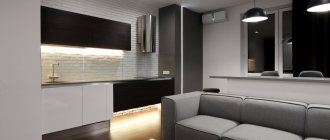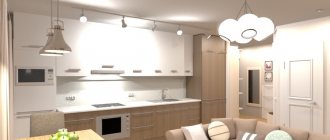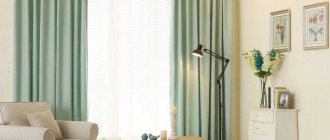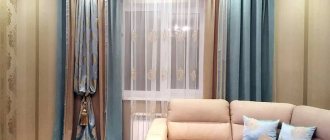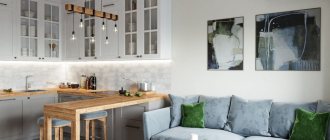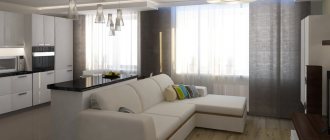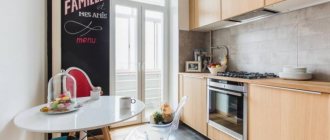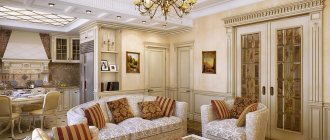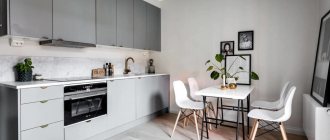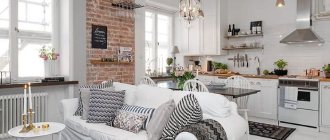Curtains for the kitchen work area - living room
When choosing curtains for the kitchen-living room work area, take into account regular changes in temperature and humidity, splashes of water and grease fly away:
- size - the smaller and darker the working area of the kitchen - living room, the lighter and more weightless the curtains are chosen. The choice of pattern also depends on the dimensions - for a small workspace a small pattern is suitable, since a large print visually reduces it;
- kitchen stove - the closer it is to the curtains, the shorter they should be. This will reduce the risk of fire. In addition, it is better to take materials treated with a special composition that is resistant to fire;
- kitchen sink - the same rule as with the stove. There are materials that are resistant to moisture, but they cannot be washed, only dry cleaning is possible;
- length - for the kitchen - living room, a good model would be a curtain up to the window sill. For a more original design, you can hang asymmetrical or arched curtains;
- material – mixed fabrics are appropriate for the kitchen-living room work area, since they absorb stains and odors less than others and do not require careful care;
- style - curtains should be combined with the interior. For example, in a classic setting, Roman or roller blinds are not appropriate.
Identical window decoration with heavy curtains
Of course, floor-length velvet curtains with a lambrequin will transform the interior of the kitchen and living room. But what will happen to them close to the hob? In addition, this is prohibited due to safety regulations. It is better to hang Roman blinds, roller blinds or blinds. It is better to take the latter from metal or plastic, since wood is more difficult to care for.
Curtains, different lengths, but with the same print
If necessary, blinds, Roman and roller blinds can be raised; excess fabric does not hang anywhere, which means it gets less dirty. You can choose any material - plain, dense, translucent, airy. To make the design complete, use different draperies.
When placing the slab near a window opening, you also need to worry about practicality. It is better to choose lightweight models, for example, Japanese panels or curtains made of natural textiles - linen, cotton.
Style
When decorating windows, you should focus on the interior style of the space. The choice of fabric, color scheme, texture, length and other parameters will depend on the features. Modern designers prefer simplicity, are not obsessed with complexity and value practicality.
Classic
The timeless style can be used for any room. It is distinguished by restraint, a combination of decorative elements and harmony. To decorate the space, you can use translucent tulle in combination with curtains. If an accent is required, you can use a complex volumetric lambrequin.
High tech
Practical and minimalist style is still popular today. Key requirements for curtains for a high-tech kitchen interior:
- sun protection materials impregnated with polyvinyl chloride;
- minimum decor and simple lines;
- lack of pomp and functionality;
- decoration without lambrequin and drapery;
- straight, clear shapes.
The high-tech interior will be complemented by roller and Roman blinds, as well as Japanese panels. Among the top colors are metallic, glossy glitter, and oil slick effect.
Loft
Slight negligence, high ceilings, industrial elements create a unique atmosphere for life and creativity. This solution is suitable for ordinary and two-level city apartments, workshops and art galleries. For the loft style, designers recommend roller blinds that can be easily rolled up and hidden from prying eyes. Cool shades with imitation of untreated wood and neutral, faceless colors are suitable for coloring.
Country
The style requirement is natural textiles. It can be durable cotton or linen. In addition, plain organza, jacquard, velvet, satin and silk are suitable for country. The colors are associated with natural patterns - green leaves, airy tree branches, wildflowers, etc. In addition, cages of different sizes, polka dots, stripes and floral patterns would be appropriate in the interior. Suitable shades for a laconic design are pastel, gray or white, pattern colors are blue, burgundy and orange.
Curtains for the dining area or dining room kitchen - living room
When planning a kitchen-living room, when the dining table is located next to the window, use light curtains that let in maximum light, for example, tulle. It is often combined with curtains. In this way, you can visually unite spaces by hanging the same curtains in the recreation area - this way the interior will be more harmonious.
A combination of thick curtains with transparent tulle
In a dining space, color and its effect on people are of great importance:
- red, orange, light brown increase the feeling of hunger;
- blue, turquoise, light blue - on the contrary, suppress it;
- yellow – has a satisfactory effect.
French
In some ways similar to the previous type, they are still different - the pattern is slightly different, the folds lie softer.
Don't try to make something like this out of coarse, dense fabric. The best option would be tulle, gabardine or satin. A delicate and airy effect is achieved through the correct combination of shape and thin material.
These curtains are suitable for a kitchen with a bay window. Use them to decorate the dining area in the kitchen, we assure you that the result will please you.
Pay attention to cornices - there are many types of them. You will have to spend time to find one that will highlight the beauty of the curtains and fit harmoniously into the interior.
Curtains for a relaxation area or hall in the kitchen - living room
Choosing window treatments for your living area has to do with workspace, area, lighting and style. There are different styles, types and shades of textiles here, the main thing is that they fit harmoniously into the design.
Short French curtains in the living room
If the window openings are located from the south, then select curtains from a cold color palette - blue, light blue, black, gray, and if from the north, then from a warm color palette - yellow, orange, green, red. Too catchy shades for curtains are used only in large kitchens and living rooms with an area of 15 square meters or more. m.
In the kitchen-living room seating area you can hang weightless, airy tulle together with thick curtains - this will make the room more fresh, cozy and bright. For solemnity, lambrequins, fringe, tails and other drapery methods are used.
When decorating a living room combined with a kitchen with curtains, several methods are used:
- Division of space. Suitable for studios where each zone is decorated in its own style. The curtains here may not overlap with each other.
- Unification of space. Curtains should overlap with each other and with textiles in other areas, for example, with pillows, tablecloths, and upholstery on chairs. Curtains can also be combined with an apron or kitchen set.
When choosing curtains for the living room, you need to ensure that they match the style of the kitchen. Practicality takes a back seat here.
Combining the kitchen with the living room using identical curtains
Types of classic cornices and fastenings to them
An important role is played not only by the material, but also by the appearance of the cornice, as well as the strength of fastening the curtains to it.
- Baguette cornices are best suited to the classic style. The fasteners are not visible behind the bar, which makes the window look complete. The baguette can be plastic with imitation of forging or wood, smooth or carved.
- Tubular cornices can be single-level or two-level, decorated with finials at the edges and made to a specific size.
The photo shows an interior with a wooden tubular cornice, on which there are translucent curtains with a floral print and garters. Here is a classic in simplicity and elegance.
- Profile cornices are convenient for decorating bay windows or corners. Mounts both on the wall and on the ceiling. Made from profile aluminum.
- A forged cornice will attract attention, so curtains should be simple. This cornice is suitable for heavy fabrics. The best method of fastening would be eyelets and rings.
- Wooden cornices can be ceiling, wall, tubular and baguette. The natural shade of wood will fit into the classic interior of any room.
The photo shows a wooden baguette in a classic style design, from which weightless tulle and smooth pastel-colored curtains fall.
Curtains can be attached to the curtain rod in different ways, depending on the weight of the fabric and the style of the room.
- Eyelet fastening is suitable for a modern classic style. This is a fastening method in which rings are sewn into the curtain fabric; it is more suitable for curtains.
- When attached to rings, the fabric is fixed on hooks, and the rings are strung on a tubular cornice.
- Classic curtains with ties look original and varied due to different tying methods (bows and different types of knots). In addition, the color of the ties may differ from the color of the curtains.
- Fabric loops, like eyelets, are threaded onto the cornice. The width of the loops and their number depend on the weight of the curtains. The loops can be on clips, in the form of braids, or sewn to the fabric.
- The drawstring hides the top of the cornice due to the high frill. This fastening is suitable for niche windows, tubular cornices, and cafe curtains. When moving, you will hear a slight rustling of the fabric, and not the knocking of rings on the cornice.
- Curtains with braid look simple and elegant due to the frequent small folds that are formed due to the tightening of the laces to the desired limit. For lush drapery, fabric should be 2 times the size of the window.
Curtains for the kitchen - living room with 2 windows
According to the designers, if there are a couple of window openings in the kitchen or living room, the curtains do not have to match each other. But there are several important factors that influence this decision:
- If both windows of the kitchen and living room are immediately located in the visible area, then it is better to decorate them with a single tulle or fabrics of similar structure or color. It’s a good idea to cover the partition with the same tulle - you’ll get the effect of one large window opening;
- If the kitchen and living room are decorated in different styles, then the curtains may be completely different;
- When decorating the kitchen area and living room differently, they use not only different shades of the same color palette, but also completely different curtains. The main thing is that they match each other according to the color wheel.
It would be a mistake to choose heavy, thick curtains for two windows, since in the work area they will only get in the way and quickly get dirty.
Different Styles of Window Curtains
If there is one window in the kitchen - living room, the choice of curtains depends on its location - in the work area, relaxation area or in the middle. The first options were discussed in the paragraphs of the same name above. When the window is in the middle, the design of the curtains should be combined with the kitchen and living room, even if they are decorated in different styles.
If the kitchen-living room is located on a high floor, you can hang one transparent tulle. For a small space, light materials without large ornaments and patterns are appropriate.
Decorating a window opening with light curtains
Choosing curtains depending on style
Designers today offer a number of solutions for kitchen windows. The fabric should correspond to the overall design and not oversaturate the space with complex patterns and bright details. How to combine:
- For luxurious interiors, heavy, expensive fabrics in a classic style and thick tulle are chosen.
- The Scandinavian style with furniture from Ikea is complemented by simple materials and neutral, solid colors.
- For minimalism and hi-tech, it is better to choose fashionable fabrics and bright design solutions.
Recommendations for choosing fabric
Every year, fabric fashion changes, new fabrics, textures, and prints appear. What was fashionable that year is considered inappropriate this year. However, there are a number of unchanging rules for selecting materials for curtains:
- Dark fabrics can only be used for large rooms.
- Heavy textures are suitable for decorating recreation areas.
- Mixed materials that are practical can be used to decorate the work area.
Curtains for the kitchen - living room with a balcony door
Often the balcony door in the living room combined with the kitchen is decorated with Roman blinds. But this is not always convenient, since when visiting the balcony you will have to lift the canvas or always keep it in the open position.
An alternative to Roman blinds are Japanese panels. They have the same simple look, but the blades can be moved to the side if necessary. Basically, they are made to order according to the required sizes. Japanese curtains protect from bright rays, smoothly distributing light throughout the room, that is, it is almost not darkened. If you want to disguise the door, use ordinary curtains with tiebacks.
Masking a balcony door with a curtain with a tieback
What fabric and color to choose
Fabric for curtains in the kitchen and living room should be easy to wash, dry quickly, and not absorb odors from food.
Window decoration with a veil
- Curtains made of dense, heavy fabrics are suitable for the recreation area, since there is minimal pollution and care for them is difficult;
- For the working model – models made of mixed materials, since they are lightweight, moisture and dirt resistant, and also do not require careful maintenance;
- More impressive models are chosen for living rooms, for example, massive curtains with a lambrequin.
French curtains in the kitchen and classic ones in the living room
It is not at all necessary to hang similar curtains in different areas of the kitchen-living room. You can leave an intersection in shade or ornament. You also need to consider the level of light protection. If this factor is not so important for the work area, then for the recreation area it comes to the fore, since the TV shines from the bright natural light or after lunch there is a desire to relax in the twilight.
Additional curtain for the window
Kitchen-living rooms impose some restrictions on the choice of color. For example, white is appropriate for the hall, but not suitable for the work area because it gets dirty. To make the combined space look harmonious, white can be found in patterns and tiebacks.
In the kitchen-living room, beige curtains look impressive, creating a harmonious and beautiful interior. They are often combined with peach curtains. Gray looks neutral, but with the right combination you can get an attractive design. The light ash color of curtains or Roman blinds will make the room sunny. Visually, the steel shade looks very bright, so it acts as an accent in the design.
Curtains of bright yellow color are often chosen. Bright colors, such as corn or saffron, are suitable for the kitchen. For the hall, you can choose vanilla, apricot or banana shades.
Visually, the space looks like a single whole, but the different intensities of shades create the correct zoning. Designers prefer to match the shades of curtains in elements of the kitchen and living room, for example, textiles, aprons, and furniture.
If the kitchen-living room windows face south, then blue will do; a cool color will bring coolness. Rich shades of ultramarine and cobalt are combined with delicate beige walls and brown floors. Blue color is suitable for a small room.
Varieties
Photos of classic curtains clearly illustrate the fact that they can be presented:
Roman curtains. This product has the appearance of a canvas, which, due to a special opening system, forms beautiful horizontal folds. There are two methods of fastening - to the window or to the window opening. Pros: aesthetic appearance, ease of maintenance. This is an ideal option for a small room.
Long curtains. Curtains of this type can either reach the floor or fall onto it. They are usually collected on the sides and secured with decorative ties. Sometimes curtains are complemented with a light curtain gathered in waves.
French curtains. Graceful waves of translucent fabric on panoramic windows create a festive atmosphere in any room. The stationary option can be supplemented with curtains by replacing them with tulle curtains. The product with a lifting device can be assembled into a lambrequin.
